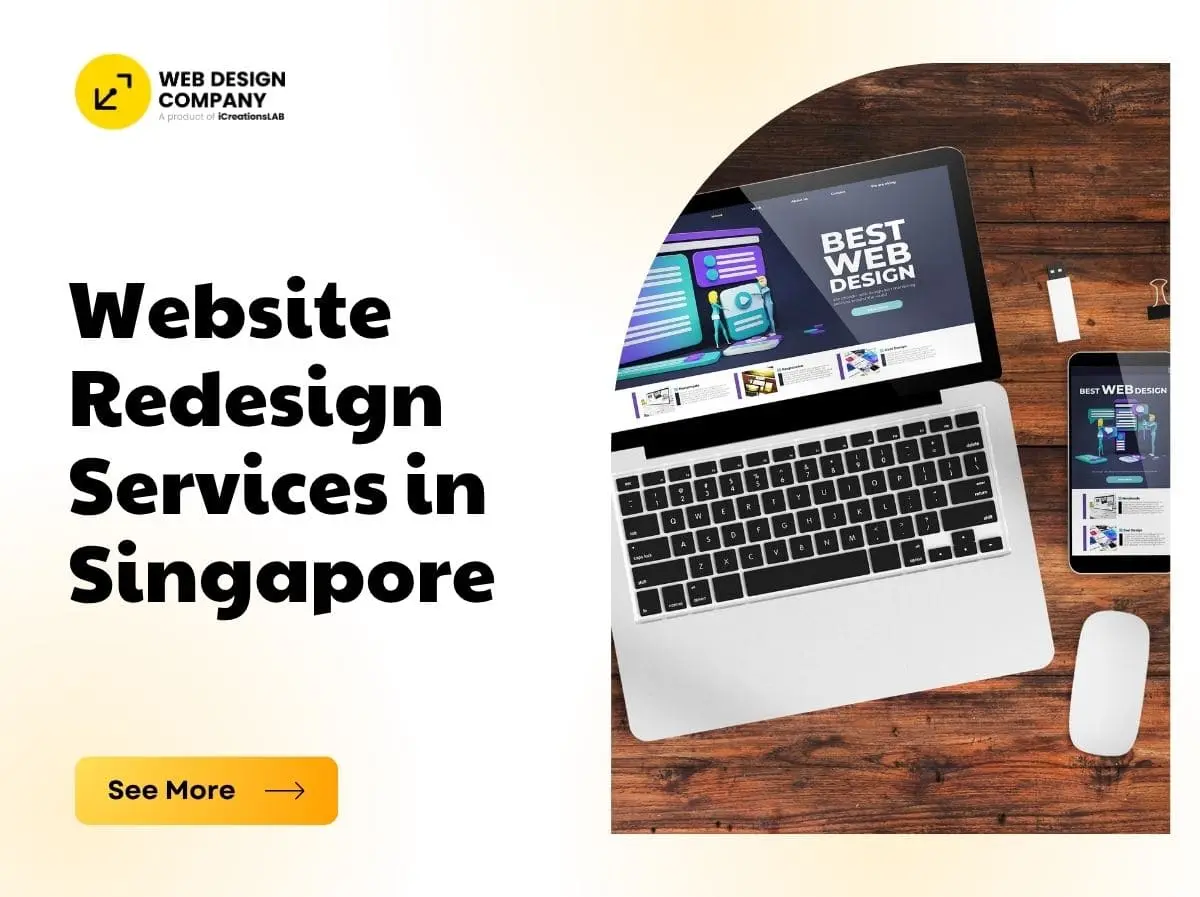
In Singapore’s fast-paced digital landscape, your website is often the first touchpoint between your brand and potential customers. If your site is outdated, slow, or hard to use, you’re likely missing out on leads, sales, and credibility.
This guide will help you determine if it’s time for a redesign and what you should expect from professional website redesign services in Singapore.
1. What Is Website Redesign and Why Does It Matter?

Website redesign is more than just changing how your website looks. It involves a full update of the design, layout, features, and technical elements to better meet the needs of your users and align with your business goals.
A well-executed redesign can make your website more modern, functional, and effective at attracting and converting visitors. It ensures that your site performs well on all devices and delivers a smooth user experience from start to finish.
Key Benefits of Redesigning Your Website:
- Improved User Experience (UX)
A redesign can make your site easier to navigate, ensuring users can quickly find the information they need. - Better Search Engine Rankings
Updating technical elements like page speed, mobile responsiveness, and structured data improves your SEO, making your site easier to find on Google. - Higher Conversion Rates
Clearer layouts, stronger calls-to-action (CTAs), and improved content flow encourage users to take action, whether it’s filling out a form or making a purchase. - A Modern, Competitive Look
A fresh design helps your brand appear current and professional, especially important in highly competitive markets. - Mobile Responsiveness and Accessibility
A redesigned site ensures compatibility across all devices and includes features that support users with different needs.
In a digitally advanced country like Singapore, users expect websites to be fast, mobile-friendly, and visually polished. A professional website revamp is often the key to staying relevant, attracting local customers, and supporting your long-term growth.
See More: Ecommerce Website Design in Singapore – What You Need to Know
2. Signs Your Website Needs a Revamp

Not sure if your website is still meeting today’s digital standards? In 2025, users in Singapore expect fast, seamless, and visually engaging websites. If your current site is falling short, it may be time for a full redesign.
Below are some clear signs that your website may need a revamp:
Outdated Design
If your website hasn’t been updated in five years or more, it likely feels outdated to visitors. Modern web design trends now focus on clean layouts, bold typography, intuitive navigation, and features like dark mode. A dated design can make your business appear unprofessional or behind the times.
High Bounce Rates or Low User Engagement
Are visitors leaving your site after just a few seconds? This could indicate that your content isn’t compelling, or your layout is confusing. A high bounce rate typically means users can’t find what they need quickly, which negatively affects conversions and SEO.
Poor Mobile Experience
With more than 90% of internet users in Singapore accessing websites from smartphones, your website must be mobile-responsive. If your site doesn’t display correctly or takes too long to load on mobile, users will leave—costing you valuable traffic and potential sales.
Security Issues
Websites that are not using HTTPS or still rely on outdated plugins and themes are vulnerable to cyberattacks. This is especially risky if you collect personal or financial data from users. A redesign can help upgrade your site’s security and protect your customers’ information.
Difficult to Update or Maintain
If updating content or uploading new products requires technical help each time, your website’s content management system (CMS) may no longer suit your needs. Redesigning your site with a modern, user-friendly CMS can save your team time and reduce operational headaches.
See More: How Much Does Website Design Cost in Singapore?
3. Benefits of Hiring Website Redesign Services in Singapore

While some business owners may try to redesign their websites on their own, working with a professional web design agency in Singapore offers many distinct advantages. A local, experienced team can help you build a high-performing website that meets both global standards and local expectations.
In-Depth Understanding of the Singapore Market
Web design agencies based in Singapore are familiar with the digital behavior of local users. They understand how Singaporeans browse, what builds trust, and what types of content perform best in this market. In addition, they are knowledgeable about compliance with important regulations such as the Personal Data Protection Act (PDPA) and the Accounting and Corporate Regulatory Authority (ACRA) requirements.
This local insight ensures that your website is not only visually appealing but also legally compliant and relevant to your audience.
Comprehensive, End-to-End Services
A professional agency typically offers full-service website redesign solutions, which may include:
- UX/UI design to improve how your website looks and functions
- Mobile responsiveness to ensure your site works well on all devices
- Speed optimisation so pages load quickly
- Search Engine Optimisation (SEO) to help your site rank better on Google
- Copywriting that communicates your message clearly and persuasively
- Website hosting and maintenance for ongoing technical support
This all-in-one approach saves time, avoids miscommunication between different service providers, and ensures consistency throughout your site.
Strategy-Focused Redesign
Redesigning a website isn’t just about making it look nicer. A reputable agency will take a strategic approach—starting with research, website audits, and understanding your business goals. They will analyze your target audience, competitors, and performance metrics to create a redesign plan that delivers real results, such as more traffic, better engagement, or higher conversions.
The goal is to align your website with your business objectives, not just refresh the visuals.
Access to Government Support (PSG Eligibility)
In Singapore, small and medium-sized businesses may be eligible for the Productivity Solutions Grant (PSG), which can subsidize up to 50% of the website redesign cost if you work with a PSG-approved vendor.
This grant makes it more affordable for businesses to invest in professional website revamp services, especially when combined with digital marketing, e-commerce integration, or SEO improvements.
See More: Creative Web Design Agency in Singapore | iCreationsLab
4. Core Elements of a Successful Website Redesign

No matter the size of your business—whether you’re a small SME or a large corporation—there are several key elements that every modern website redesign must include. These features ensure your site remains relevant, user-friendly, and competitive in 2025 and beyond.
a. Mobile-First Design
With Singapore’s high smartphone penetration, most users will access your site via mobile. A mobile-first design approach ensures that your website looks great and functions smoothly across all screen sizes. This means fast-loading pages, content that’s easy to scroll through, and touch-friendly buttons and menus.
A mobile-first website also performs better in Google search results, since mobile usability is a core ranking factor.
b. Strong SEO Foundation
If your website can’t be found on search engines, it won’t generate traffic or leads. A successful redesign must include SEO best practices from the start. This includes:
- Meta titles and descriptions that are clear and keyword-optimized
- Proper use of heading tags (H1, H2, etc.) with targeted keywords
- Clean, readable URLs (e.g., yoursite.com/services/web-design)
- Schema markup for enhanced visibility in search results (e.g., product, review, or FAQ snippets)
- Optimised site speed and responsive design for technical SEO performance
By incorporating SEO into your redesign, you improve your website’s visibility and attract more organic traffic from search engines like Google Singapore.
c. Clear Call-to-Actions (CTAs) and User Navigation
Your website should guide users toward taking the next step—whether that’s booking a consultation, filling out a form, or making a purchase. Clear, strategically placed call-to-action buttons help move users through the customer journey.
At the same time, your website should have a well-structured menu and logical navigation. Group pages under clear categories and use a sticky header or visible navigation bar to help users find what they need quickly.
Examples of strong CTAs include:
- Contact Us for a Free Quote
- Schedule a Call
- View Our Services
- Chat with Our Team
d. Local Trust Indicators
In Singapore, where credibility and reliability are highly valued, your website should include specific elements that build trust with local visitors. These may include:
- Testimonials or reviews from Singaporean clients
- Use of a .sg domain or country-specific content
- Displaying your registered business number and company address
- A map showing your physical location, if relevant
- Integration with familiar payment options such as PayNow, GrabPay, or local bank transfers
These trust signals help reassure potential customers that your business is legitimate and easy to reach.
See More: Spring Clean Your Website: The Complete Guide to Better UX & SEO
5. Step-by-Step Process of a Website Redesign
Understanding the full process behind a website redesign can help you collaborate effectively with your web agency and set clear expectations. A structured approach also ensures that every important aspect—from user experience to performance—is covered.
Step 1: Website Audit
The first step is to conduct a complete review of your existing website. This audit will assess:
- Design and visual appearance
- User experience and navigation flow
- Page speed and mobile responsiveness
- Technical and on-page SEO
- Quality and relevance of content
The goal is to identify what’s working and what needs improvement.
Step 2: Strategy Development
Next, your agency will develop a custom redesign strategy based on your business objectives. This typically includes:
- Defining your goals (such as increasing leads, improving SEO, or enhancing user engagement)
- Researching your top competitors
- Identifying target keywords for SEO
- Creating user personas to guide design and messaging
This phase ensures the redesign is aligned with your business direction and target audience.
Step 3: Wireframing and Prototyping
Once the strategy is in place, your agency will create wireframes—basic layouts that show the structure of your new site. Wireframes help map out the placement of content, navigation elements, and call-to-actions.
In some cases, an interactive prototype will also be developed. This allows you to click through and preview how users will interact with the new design before development begins.
Step 4: Design and Development
With the layout approved, the team moves on to full design and coding. Designers create visuals using your brand colours, typography, and imagery. Developers then build the site using a content management system (CMS) such as WordPress, Webflow, or Shopify—depending on your business needs.
This phase also includes integrating any tools or features, such as contact forms, booking systems, payment gateways, or CRM platforms.
Step 5: Testing and Quality Assurance (QA)
Before launching, your website must go through a thorough testing process. This includes:
- Mobile and desktop compatibility testing across different devices and browsers
- Speed and performance testing
- Checking for broken links and form functionality
- Validating on-page SEO setup and structured data
- Ensuring accessibility for users with disabilities
Testing helps ensure a smooth, professional experience for all visitors once the site goes live.
Step 6: Launch and Post-Support
Once your website is ready and approved, it goes live. However, your partnership with the web agency shouldn’t end there. Most professional teams provide post-launch support, including:
- Fixing any unexpected bugs
- Setting up analytics tracking (such as Google Analytics 4 or Facebook Pixel)
- Monitoring site performance during the first weeks after launch
- Providing training so your team can manage the CMS and update content easily
This ongoing support helps ensure that your website continues to perform well over time.
See More: Protect, Perform, Prosper: Why Your Website Needs Ongoing Maintenance
6. Cost of Website Redesign in Singapore (2025)
The cost of a website redesign in Singapore can vary significantly depending on the scope of your project, the features you require, and the expertise of the design agency you choose. Whether you’re a small business looking to refresh your site or an enterprise planning a full custom rebuild, understanding the pricing breakdown can help you make informed decisions.
General Pricing Overview
Here’s a rough estimate of what businesses can expect to pay for website redesign services in Singapore in 2025:
| Type of Website Redesign | Estimated Cost (SGD) |
| Basic Template Redesign | $1,500 – $3,000 |
| Custom WordPress or Shopify Revamp | $3,500 – $7,000 |
| Advanced Custom Design (UI/UX) | $8,000 – $15,000 or more |
| PSG-Subsidised Packages (if eligible) | From $1,200 after subsidy |
These ranges are based on industry standards and may vary depending on the agency, the complexity of your site, and your specific goals.
Key Factors That Influence Website Redesign Costs
Several elements contribute to the final cost of your redesign project. Here are the most common cost drivers:
- Number of Pages
A small brochure website with 5 to 8 pages will cost less than a large site with 20+ service or product pages, blog sections, and landing pages. - Custom Design vs. Template-Based
Template redesigns are more affordable but offer less flexibility and uniqueness. A custom design, built from scratch based on your brand and goals, typically costs more but delivers a tailored user experience. - SEO and Content Writing
Professional content writing with keyword optimization is essential for improving search engine rankings. If your agency provides SEO-focused copywriting, this will add to the cost but greatly enhance performance. - Platform Migration
Moving from one CMS (such as Wix or Joomla) to another (like WordPress or Shopify) requires time and technical effort. This can affect the timeline and budget. - Booking or Payment Integration
If you require features such as online appointment booking, PayNow checkout, or subscription payments, expect additional development time and cost. - Multilingual Support
If you’re targeting multiple language groups in Singapore (such as English, Chinese, and Malay), your redesign will need language toggles, translated content, and possibly separate design considerations for each version.
7. Choosing the Right Website Redesign Company in Singapore

Selecting the right web design agency is one of the most important steps in your website revamp journey. A skilled and reliable partner will not only deliver a beautiful site but also ensure that it functions well, supports your business goals, and complies with local regulations.
What to Look For in a Website Redesign Company
Here are some key criteria to consider when evaluating web design agencies in Singapore:
- Proven Local Experience
Look for a portfolio that includes work done for Singapore-based businesses. A strong local track record shows that the agency understands regional user preferences, design standards, and market trends. - Transparent Pricing and Timelines
A trustworthy agency will provide clear project timelines, scope of work, and pricing details upfront. Avoid companies that provide vague estimates or charge hidden fees. - Combined Expertise in SEO and Design
Your website must not only look good but also rank well on Google. Choose a company with expertise in both visual design and search engine optimisation to ensure strong performance after launch. - Post-Launch Support and Maintenance
After the site goes live, ongoing support is essential for fixing bugs, updating plugins, and helping your team manage content. Ensure the agency includes post-launch assistance as part of their offering. - Understanding of Singapore Business Regulations
A Singapore-based agency will be familiar with data protection laws (such as the PDPA), ACRA requirements, and local tax considerations—helping you avoid compliance issues. - PSG Grant Eligibility
If you’re planning to apply for the Productivity Solutions Grant (PSG), make sure the agency is a pre-approved vendor. This can significantly reduce your total redesign cost if your business qualifies.
Recommended Platforms Based on Business Needs
Your redesign agency may suggest using a specific platform depending on your goals. Here’s a breakdown of popular options in Singapore:
- WordPress
Ideal for content-driven websites, blogs, or service businesses. It offers excellent SEO flexibility and a wide range of plugins for customisation. - Shopify
Perfect for ecommerce businesses that need a reliable, secure platform with built-in payment processing, inventory management, and marketing tools. - Webflow
Great for businesses that want cutting-edge design and modern animations. It allows full visual control without the need for code, and is suitable for startups, creative agencies, or portfolio sites. - Wix
Best for small businesses or solopreneurs looking for a budget-friendly, quick-to-launch website. It offers drag-and-drop tools and pre-designed templates, making it easy to manage in-house.
See More: Is It Time for a Website Revamp? Complete Guide in 2025
8. Website Redesign Best Practices for Singaporean Businesses
A successful website redesign goes beyond aesthetics. To truly deliver value, your website must perform well, reflect your brand identity, and meet the expectations of modern users in Singapore. Below are several key best practices to follow:
Prioritise Fast Loading Speed
Speed is a top priority for today’s internet users. In Singapore, where digital adoption is high, visitors expect your website to load in under three seconds. To achieve this:
- Compress and optimise images for faster page loads
- Minimise the use of heavy scripts and third-party plugins
- Use efficient hosting solutions with local or regional servers
- Implement browser caching and content delivery networks (CDNs)
A faster site improves user experience and positively impacts your search engine rankings.
Improve Accessibility for All Users
An accessible website ensures that everyone, including people with disabilities, can navigate and interact with your content. Consider the following features:
- Add alt text to all images so screen readers can describe them
- Ensure that your website can be used with keyboard navigation alone
- Provide options for font size adjustment and sufficient contrast between text and background
- Follow accessibility guidelines such as WCAG 2.1
Making your website inclusive not only improves usability but also shows social responsibility.
Integrate Tools for Local Marketing and Tracking
To maximise performance, your website should include modern tools that allow you to measure and enhance your marketing efforts. Useful tools for Singapore-based businesses include:
- WhatsApp Business: Enable quick and convenient customer communication
- Facebook Pixel: Track user behaviour and improve your social media ad targeting
- Google Analytics 4 (GA4): Monitor site performance, traffic sources, and conversions
- Live Chat Tools: Install platforms like Tawk.to to engage visitors in real-time
These tools help turn your website into a dynamic marketing and sales engine.
Localise Your Content for Singapore
Creating locally relevant content is essential to connecting with your target audience. Your website should include search-optimised content tailored to the Singapore market. Examples include:
- Blog posts about local industry trends or business tips
- Product or service descriptions that use region-specific keywords
- Landing pages targeting specific locations or business hubs (e.g., Raffles Place, Orchard, Jurong)
- Common search terms such as:
- “Web design agency near Raffles Place”
- “Corporate website revamp Singapore”
- “Mobile-friendly SME website Singapore”
Local SEO helps you rank higher in Singapore-based searches and attract more qualified leads.
Conclusion: Is It Time to Redesign Your Website?
If your website no longer represents your brand, performs poorly on mobile, or fails to convert visitors into leads or customers—it’s time for a revamp.
Investing in a professional website redesign is not just about keeping up with trends. It’s about ensuring that your business stays relevant, competitive, and visible in Singapore’s fast-paced digital environment. Whether you’re applying for a government grant like the PSG, aiming to improve user experience, or wanting to boost your SEO performance, a redesigned website can deliver measurable impact.
Your website is often the first impression your customers have of your business. Don’t let an outdated or underperforming site hold you back.
Ready to Revamp Your Website?
If you’re looking for trusted local experts to guide your website redesign, iCreationsLab is here to help. We specialise in building modern, mobile-optimised, and high-converting websites tailored to Singaporean businesses.
Let’s create a faster, smarter, and more impactful digital presence—together.
